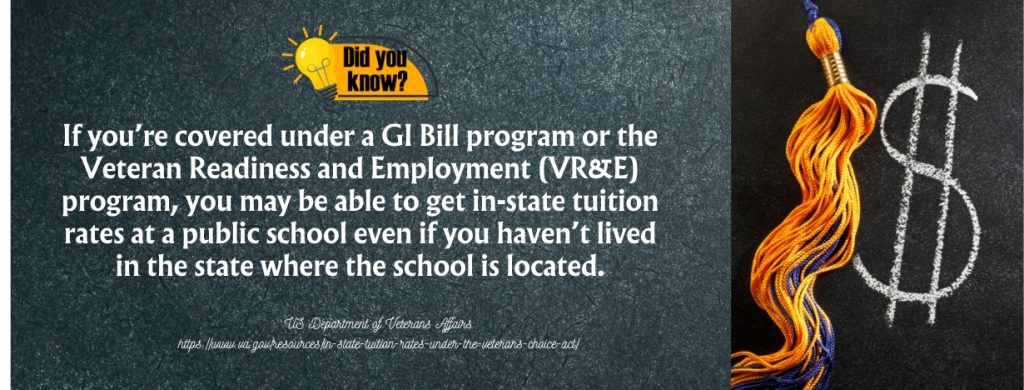How do I Get In-State Tuition at an Out-of-State College?
Tuition is the most essential consideration for attending college. The important distinction in tuition rates centers around in-state and out-of-state tuition.
Each state maintains its own system of public colleges and universities, funded through tax revenue of a state’s residents.
This system holds for all states in the country, though admittedly, some states are economically stronger, which also translates to them having more robust and prestigious public university systems than others. In this case, the most desirable public universities (such as the Public Ivies) tend to be concentrated in a few states.
It’s essential to understand the difference between in-state and out-of-state tuition costs.

The Educational System
States prioritize the welfare of its residents in all its services. The same can be said of its educational system. Generally, public colleges and universities implement a two-tiered tuition rate, with non-resident students being charged higher rates than residents.
The difference varies between states, but did you know that an out-of-state student can typically expect to be charged up to three times the in-state tuition rate? There’s an added nuance: some states have more than one public university system that does not charge the same in-state and out-of-state tuition.
Some universities have higher out-of-state tuition rates than others in the same state.
Going Out-of-State: Advantages and Disadvantages

Like any other undertaking in life, choosing a particular college or university over another has its own associated set of advantages and disadvantages. There are a number of reasons for being interested in a university in another state.
Let’s take a look at some of these.
Advantage: Choice
You may or may not be born in a state with highly desirable colleges and universities. The disparity that exists between states is just as true for their educational systems, and it’s normal for students to have one or more dream campuses.
Prestige admittedly has its effects; for one, many employers would give additional points to graduates of particular universities over others, and in some fields, you may see it as an advantage to go for a particular university with marketability in mind.
Advantage: Academic Excellence and Specialization in a Particular Field
Some universities are also regarded as centers of excellence for a particular field, and your chosen field of interest may be better served at a university in another state. Some fields are necessarily very limited in terms of choice.
For example, universities specializing & excelling in marine sciences are in the East & West Coasts. There are also a number of universities known to excel in other fields like agriculture, environmental sciences, geology, and more. In this regard, it would make a lot of sense for many students interested in certain fields to go out of state.
Disadvantage: Tuition Rates
Taking only tuition rates into account and disregarding financial aid, scholarships, and other means, it becomes clear that out-of-state tuition rates do quickly run very steep compared to in-state tuition rates for the same degree.
For most students, this can translate to a longer time spent paying off any student loan debts they might incur. This goes back to the state’s basic need of prioritizing its residents and making sure that they’re given priority when it comes to its various services and institutions.
Disadvantage: Other Cost Considerations
There are also other cost considerations to going out-of-state, aside from the higher tuition rates. One practical consideration is distance from home. For many students, this can translate to increased travel expenses should they need or want to travel home. Going out of state can potentially mean seeing less of home.
The cost of living is also an important consideration. Depending on where you live, other states may be more expensive to live in for college, and it’s safe to assume that a particular university will have limited space in its on-campus living spaces. Aside from rent, other things like groceries or going out can also potentially become more expensive.
Basic Requirements for In-State Tuition

The most basic (but somewhat complex) requirement for in-state tuition is residency. A good rule of thumb for residency is the 183-day rule, i.e., spending at least half a year in a particular state.
The 183-day rule, however, is generally followed for taxation purposes, and state residency gets a bit complicated when talking about college. As a student, you are generally considered, concerning your parents, i.e., as a dependent, and your residency would generally be where your parents live unless you can demonstrate Financial Independence, which is a topic all on its own.
Qualifying for in-state residency for the purposes of going to college is generally considered impractical. To be considered for residency, students must have been present in the state for at least 12 months before enrolling (which would be impossible for many).
Students also typically need to provide various documentary proofs of residence, such as driver’s licenses, voter registration, etc., and an adequate purpose for relocating to a state (that isn’t educational) must also be provided.
As a whole, for going to college, there are better ways to overcome the higher costs associated with going out-of-state.
Helpful Ways to Offset High Costs of Out-of-State Education

Since out-of-state tuition is often three times more expensive than in-state tuition, many students seek ways to offset the high cost of their college education if they live out of state.
Fortunately, there are many ways to do just that. The following tips will help you fund your degree, potentially helping you save money in the process.
Look for schools that offer in-state rates to qualified students.
The very first tip in the list involves thorough research of potential schools that offer the program of your choice. There are some universities and colleges that provide affordable tuition rates, even for non-residents.
Public universities like Oklahoma Panhandle State University and Mississippi Valley State University have a less expensive national average for out-of-state tuition fees, usually hovering between $300 to $500.
Alternatively, you may also want to consider online programs, in particular higher learning institutions with a flat rate tuition, regardless of whether you are in-state or out-of-state. Online learning will allow you to save precious money on transportation and housing costs.
Check if Tuition Reciprocity Agreements are available.
In-state tuition is generally cheaper because resident students have parents who pay taxes and help fund public universities and colleges in the state. Luckily, out-of-state students may be able to offset the cost by taking advantage of the tuition reciprocity agreement.
These agreements help even out the playing field by reducing tuition rates at public colleges and universities in participating states. This helps non-resident students pay lower out-of-state tuition rates. In return, higher learning institutions that participate in this agreement will be able to boost enrollment.
The tuition reciprocity agreement is often regional. It is usually applicable to large areas such as the Midwest and New England. Pairs of states may also enter into such agreements, like Colorado and New Mexico. However, it is important to note that not all colleges take part in reciprocity agreements, and in cases where they are available, not all programs qualify for such.
Look for Legacy Scholarships.
While there are debates surrounding legacy admissions, this method can still be a worthwhile consideration if you want to bring down the cost of your tuition rate should you decide to go to a university outside of your state.
Legacy applicants refer to students whose family has strong ties with the university. They can be children or descendants of alumni. This increases your chances of getting admitted into a particular university. Beyond the advantages it poses in the admission process, a legacy status can also be a way for you to reduce tuition rates.
Legacy scholarships are typically open to family members of alumni, such as in the case of Auburn University’s Auburn Alumni Association Endowed Scholarship and the University of Albany’s Bertha Brimmer Legacy Scholarship.
It can also be open to those who seek to follow a certain career path, like the Elizabeth Olson Legacy Scholarship – Interior Design and Army Women’s Foundation Legacy Scholarships.
Verify tuition discounts for neighboring states.
Various regions in the country offer regional exchange programs or tuition discounts for students who want to attend a university in another state, all without having to pay out-of-state tuition rates.
The Midwest Student Exchange is one good example. This is available for states in the Midwestern Region, such as Illinois, Michigan, Nebraska, and Wisconsin, among others. The program provides students with reduced tuition, in particular, at Midwest private and public higher learning institutions.
The New England Regional Student Program also offers the same opportunity. It is open for eligible students who are enrolled in an approved major that is not available in their home state’s public universities and colleges.
In the Western Region, such as the states of California, Colorado, Alaska, Arizona, and Utah, the Western Undergraduate Exchange is available for students. It was established by the Western Interstate Commission for Higher Education.
Take advantage of financial aid programs.
Many colleges and universities in the country offer financial aid assistance to qualified students. If you have an excellent academic record, you will have higher chances of qualifying for scholarships, grants, and other financial aid options. It is always a good idea to check for potential schools of your choice.
You may find that some of these institutions offer scholarships for those who excel academically, with benefits large enough to offset the hefty tuition costs of an out-of-state student. Start your research by checking the deadlines, placement process, and application methods for these financial aid options.
Consider becoming a state resident.
Another option to pay for in-state tuition as an out-of-state student is establishing residence in the state of the university you chose. Of course, this does not require you to be a resident in the strictest sense. While the process is often long and complex, becoming a resident is one of the foolproof ways to benefit from in-state tuition.
Basically, you can claim residency in a state where you spend the most time. Many states require residents to spend at least 183 days to be able to claim that they live there.
Relocating is not as simple as opening a bank account or changing your driver’s license. It involves a long and often arduous process. The most important things you need to remember include thinking over the purpose of your relocation. If you state that your purpose for moving into a new state is because of educational goals, you will find that most states won’t grant you residency.
You need to make sure that you are financially independent in the state for at least a year before you can enroll in a school.
Additional Information:
